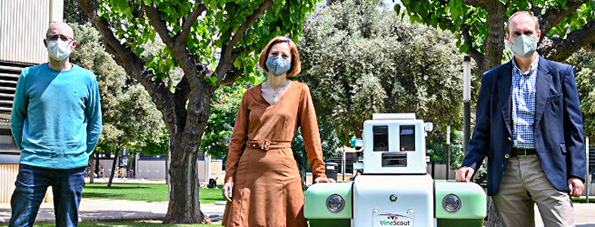VineScout, the observation robot for forthcoming viticulture
VineScout assists the winegrower to optimize irrigation or plan the harvest in the most efficient manner
[ 10/05/2021 ]
The viticulture of the future has a partner in robotics, big data and artificial intelligence. Researchers from the Universitat Politècnica de València (UPV) have developed and patented a new agricultural robot –together with its navigation system and data processing method– which, through different sensors, allows the state of the vine to be recorded at all times and helps the winegrower to get the most out of his vineyard. The result of seven years of work, it is the first fully electric viticultural observation robot, with an autonomy for at least two days, and developed internationally from an agronomic point of view.
VineScout measures key parameters of the vineyard in a fully autonomous way that allow estimating its water needs, vegetative development or anticipating the variation in the degree of maturity within the same plot. It does all this thanks to the combination of a number of environmental, radiometric and spectral sensors.
“With this technology, the VineScout robot is able to monitor the vineyard as many times as the winegrower needs, helping him to make a more rational use of water and, in general, to know the state of the vineyard through objective indicators, such as differences in plant vigour or properties of the fruits within the same vineyard. In this way, it helps in the harvest, fertilization or watering in a more efficient way”, explains Francisco Rovira, director of the Laboratory of Agricultural Robotics (ARL) of the Universitat Politècnica de València.
According to Rovira, the robot collects each piece of data on the ground, at less than a meter away from the vines –without touching the crop at any time– which translates into highly reliable and precise information, since each point is recorded with its GPS positioning, indicating the time and place where each measurement has been made.
“VineScout it is capable of registering around 12,000 measuring points per hour, each point containing 30 pieces of data; while traditional manual sampling barely reaches 40 measurement points per hour, which gives an idea of how this robot can facilitate work for winegrowers”, adds Verónica Saiz, researcher at the Laboratory of Agricultural Robotics (ARL) of the Universitat Politècnica de València. And it can even take samples at night time too, thanks to its night navigation system.
“With all the data that the robot records and processes, the producer obtains a map of his plot, which synthesizes the key information necessary for advanced crop management. VineScout does not replace the winegrower, it facilitate his work, avoiding him from having to do the hardest task in the field and enhancing his knowledge and experience, which is now nourished with more precise and more quickly updated information,” says Francisco Rovira.
GPS independent
To navigate through the vineyards, the robot incorporates a system totally independent of the GPS signal, one of the great advantages and differences with respect to other systems on the market. In this way, it does not require the reloading of pre-recorded maps, something that winegrowers are not used to and that ends up being a deterring factor for the adoption of digital technologies. Thanks to it, VineScout is able to navigate through the vines autonomously, avoiding obstacles and collisions.
“VineScout incorporates three sensor devices at the front. Two of them allow the system to navigate in a two-dimensional network and do not require the intervention of any operator to guide it when the robot moves between rows. In addition, the security system makes it stop at any obstacle that may appear on the road, waiting seven seconds for the path to clear or stopping the robot safely and acoustically warning the operator if the obstacle is permanent”, adds Andrés Cuenca, also from the UPV’s Laboratory of Agricultural Robotics.
In this way, VineScout opens the door to automation in crops where GPS technology or another Global Navigation Satellite System (GNSS) cannot be permanently and reliably guaranteed.
Other applications: harvesters, sprayers...
This system has been implemented in a ground robot whose main objective is to collect data from crops, but it could be implemented in many other autonomous systems, such as harvesters, weed removal machinery and sprayers for crop protection.
“VineScout is a completely new approach to agricultural automation for trellising crops, with multiple benefits: it is a stand-alone system that can be used on fields where the GNSS signal cannot be permanently guaranteed; it paves the way to the use of big-data in agriculture; provides critical information on key factors for sustainable agriculture; allows the integration of other sensors to expand its information capacity; and, no matter how demanding the environmental conditions, it has proven to be robust and reliable”, concludes Francisco Rovira.
Outstanding news
 ARWU 2023
ARWU 2023
The Shanghai ranking reaffirms the UPV as the best polytechnic in Spain for yet another year
 Science Meets Regions CV 2023
Science Meets Regions CV 2023
The UPV and the Almussafes City Council begin a collaboration in search of solutions to maintain the automobile sector in the Valencia Region
 Scientific reference
Scientific reference
Avelino Corma, Distinguished Research Assistant at the UPV, awarded an Honorary Doctorate by the University of Huelva
 Micronanofabs NTC UPV-PERTE CHIP Conference
Micronanofabs NTC UPV-PERTE CHIP Conference
María Marced, TSMC Europe president: "The sector's future is bright, the market is expected to double by 2030"
 Goya nomination
Goya nomination
Javier Polo, who holds a degree in Audiovisual Communication from the UPV, directs the successful short documentary Una terapia de mierda
 Sant Carles Medal 2023
Sant Carles Medal 2023
The Faculty of Fine Arts of the UPV awards the Sant Carles Medal 2023 to outstanding Valencian art and culture figures







